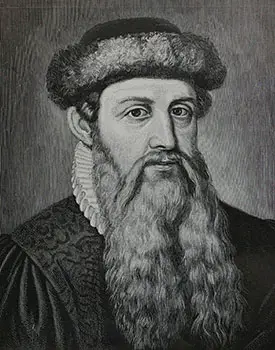Johannes Gutenberg
Johannes Guttenberg was a German goldsmith, printer and publisher. He is best known for developing a Movable Type for printing. He used his method to print Europe’s first major printed book, the ‘Forty Two Line’ Bible in 1455. Gutenberg is credited with inventing one of the most important technologies that subsequently ushered in the renaissance period and an age of enlightenment in Europe.
His contribution went a long way in providing impetus to the age of learning and spread of education in masses. Gutenberg improved the process of printing by introducing mass-producing movable type and use of oil based ink for printing of books.


Early Life: Gutenberg was born in 1398 in German city Mainz. Certain historians contend that he was born in 1395. However; there is no certain evidence regarding his year of birth. Gutenberg’s father was a German trader who was involved in cloth trade. His family had Patrician roots. In 1411, an agitation broke out in Mainz against Patricians and as a result Gutenberg’s family had to relocate.
According to certain accounts, his family moved to Strasbourg in France. Gutenberg possibly studied at University of Erfurt. His father died in 1419 and a letter written by him in 1434 confirms that he was residing in Strasbourg. Gutenberg started working in Strasbourg militia as a goldsmith but from where he learnt this trade is not known.

Invention of movable Type: During his stay in Strasbourg, Gutenberg started working on printing press. He was already familiar with the process of book making. In 1448, Gutenberg returned to Mainz, the city of his birth. There he borrowed money from various people and started working on his movable type design. By 1450, his prototype was in functional state and the first item to be printed through it was a German poem. Gutenberg then borrowed 800 guilders from wealthy money lender, Johann Fust.
Fust’s son in law, Peter Schoffer also joined the project. It is speculated that Gutenberg and Fust setup two separate presses which were separately used to print bible and other texts. In 1455, Gutenberg published his first Forty Two line bible called, Gutenberg Bible. In all, he printed one hundred and eighty copies of it. During this time, Gutenberg’s press printed thousands of texts for the church.
In 1456, Gutenberg and Fust fell out. Fust sued Gutenberg in the court of archbishop. He accused Gutenberg of misappropriating the funds he lent him. The court decided in favor of Fust and handed him the ownership of the Bible printing press and half of the printed Bibles. This development had a devastating effect on the financial standing of Gutenberg. He however; continued to operate a small printing shop and continued to print bibles in the town of Bamberg.
Some historians also believe that he also printed three hundred copies of Catholicon Dictionary in Mainz around 1460. However, this can not be ascertained as Gutenberg never printed his name on the books he printed.

Later Life: In 1462, after the Mainz Diocesan Feud, Archbishop Adolp Von Nassau exiled Gutenberg from Mainz. He settled in the Eltville and managed a small press belonging to Bechtermunze Brothers. In 1465, Von Nassau apparently had a change of heart for Gutenberg.
He bestowed upon him the title of Hoffman (Gentleman of Court) and also approved a monthly stipend, a court outfit and tax free grain and wine. According to several accounts, he continued the printing business but since he did not put his name on his published texts, it is not possible to know for certain how much printing work he accomplished.
During his last years, Gutenberg became blind and was plagued by frail health. In 1468, Gutenberg died and was buried in Franciscan Church in Mainz. The church and its cemetery were destroyed later on and Gutenberg’s grave was lost. Despite being unsuccessful financially in his life, Johannes Gutenberg played an important part in making printing a reality which can be credited with speeding up the renaissance.




